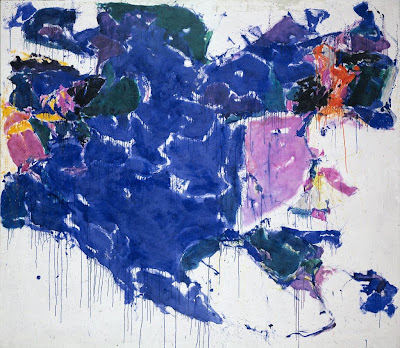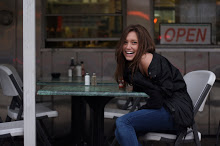
Saturday, December 25, 2010
The Season of Lights (and the art that comes with)

Wednesday, November 10, 2010
Language
My best friend Yael, who happens to be an English major and is thus invested in this sort of thing, just showed me a super cute website, www.savethewords.com , which you should all check out.
In addition to it's aesthetic appeal, the concept is "super cute," to use Yael's words. I think it's like a combination of adopt-a-high-way and dictionary.com's word of the day... Perhaps it doesn't quite relate to making art accessible, (or maybe it does by virtue of the fact that it enables people to better express themselves by bringing overlooked / esoteric words to our awareness,) but either way, I'll consider it "preservation of the arts," which is an important cause too.
Thursday, October 21, 2010
Young Talent
Thoughts on this past year:
In terms of art, AD Projects’ “Piles”, wins my award for most noteworthy exhibition of 2009/2010. AD Projects is an organization founded by Jillian Murphy, Abigail Merrick, and Katherine Cohen – three young women who work/worked at Gagosian Gallery. The name AD Projects stands for after dark, because all of the work that goes into producing an AD Projects show is done after regular business hours. Essentially Jill, Abby, and Kat find unused spaces around NYC (and soon beyond), get permission from the landlords to fill the spots with art, and open them to the public under the name AD Projects. They create win/win situations for all parties involved – they get experience curating exhibitions and selling art, the public get to see art for free, the up and coming artists they show get exposure, and landlords get to foster creativity through neighborhood shaping ventures.
 There are a number of works from the exhibition that stick out in my mind. For example, there was a large carpet-esque spread of black alphabet noodles, which looked like letters fallen from the page of a book. At first glance, it’s hard to notice that the black void is made of tiny letters, thus referencing minimalist works by artists like Ad Reinhart, with his entirely black paintings, and Karl Andre’s copper squares that lay on the floors of institutions like the MoMA. But given that that connection is rather esoteric, I was glad creator Adam Bateman was there to shed light on the piece. Bateman said that the piece is supposed to make you question the meaning of words, letters, and symbols. When taken out of context or removed from their supposed order, they become arbitrary, or if nothing else their meaning changes entirely. More broadly, Bateman said, “My work has questioned the relationship between language and objects, especially art objects…”
There are a number of works from the exhibition that stick out in my mind. For example, there was a large carpet-esque spread of black alphabet noodles, which looked like letters fallen from the page of a book. At first glance, it’s hard to notice that the black void is made of tiny letters, thus referencing minimalist works by artists like Ad Reinhart, with his entirely black paintings, and Karl Andre’s copper squares that lay on the floors of institutions like the MoMA. But given that that connection is rather esoteric, I was glad creator Adam Bateman was there to shed light on the piece. Bateman said that the piece is supposed to make you question the meaning of words, letters, and symbols. When taken out of context or removed from their supposed order, they become arbitrary, or if nothing else their meaning changes entirely. More broadly, Bateman said, “My work has questioned the relationship between language and objects, especially art objects…”
A more personal/emotional work that I found interesting was a series of three pieces by artist Andy Monk. The works were floor plans of his former apartments made of matches that are stuck into plaster. After Monk moves out of an apartment, he creates a new work for the series and then burns the matches as a sort of "happening". It reminded me a lot of a pre-Passover custom to symbolically burn your sins, as a way to move forward. Clearly Monk’s old apartments aren’t sins, but the point is still the same, about closure and moving completely into the next phase, or stage. What remains of Monks works after the burning is plaster adorned with used matches, which deteriorate over time - just like the memories from those spaces fade as time passes... The work is sad, and perhaps a little bit harsh, (particularly in the case of his family home, which he moved out of after his parents' divorce,) but it’d so well thought out and filled with so many layers of meaning that I couldn't help but be drawn to it.
On that note, I try and live by the motto that I will always learn something new from, and see something new in, a work of art no matter how many times I look at it, but I must say, sometimes it’s just nice to stumble upon some fresh, young talent—to see art that truly embodies an innovative way of viewing the world…
Wednesday, September 15, 2010
When Religion and Art Are One...
P.S. In my book the 900 sukkah will always be the winner!
Sunday, August 1, 2010
Performance


Thursday, July 29, 2010
Meaningful Conversation
 With exception to the book's great cover, the only other part of the book I found valuable was the following line: "Most paintings are like one-liners; once you get it, that's the end of the experience. The best works of art...reveal something fresh whenever you look at them (p.237)."
With exception to the book's great cover, the only other part of the book I found valuable was the following line: "Most paintings are like one-liners; once you get it, that's the end of the experience. The best works of art...reveal something fresh whenever you look at them (p.237)."On that note, Mitch and I have begun what I'm calling "virtual collections." This means we've created photo albums on Facebook that contain images of works of art that speak to us in some way - images we are happy to look at again and again because of their aesthetic, symbolic, or narrative qualities. We're hoping this idea will be contagious and that many people will start creating virtual collections...
My father pointed out virutal collections are a form of "disruptive innovation." Disruptive innovation is Clayton Christensen's theory that innovations disrupt existing markets by creating products or services that are more accessible, and though they are often less powerful they are still good enough to get the job done. So, while virutal collections may not be as moving or inspirational as seeing the real works in say a museum, for most people they might be good to get the job done, good enough to encourage them to think about art!
Perhaps the best part of virtual collections are that they can provoke conversations that start with, "Hey, I saw that new piece you posted... What do you like about that piece? What's that piece about?" As apposed to, "Saw you hit up another party last week..."
After all, there's nothing better than meaningful conversation - supposedly it's the key to happiness!
Wednesday, July 21, 2010
Truth
Wednesday, June 30, 2010
Discoveries


Sunday, June 27, 2010
Abstract Expressionism




Thursday, June 24, 2010
Thursday, June 17, 2010
Art Fun
Monday, May 31, 2010
Louise Bourgeois...
 ...passed away today, at age 98. One of the most influential, accomplished women artists ever - a feminist, a comedian, a cultural iconoclast who challenged conformity by dipping into untouched mediums and taboo subject matter, a cutting edge player in a cut throat culture... An art historical treasure.
...passed away today, at age 98. One of the most influential, accomplished women artists ever - a feminist, a comedian, a cultural iconoclast who challenged conformity by dipping into untouched mediums and taboo subject matter, a cutting edge player in a cut throat culture... An art historical treasure. Friday, May 21, 2010
Transcendence






These images are by an Italian artist named Alberto Seveso who I found on Behance.net. They magically create the illusion that they transcend the boundaries between photography, sculpture, painting, and textile. They are beautiful but eerily bodily. They are photographs of varnish dropping into a fishbowl. Seveso calls them Medicina Rossa. To see the blue sequence click here.
Perfect Imperfections

Tuesday, May 18, 2010
Being Busy

Anyway, I've been thinking about Gerhard Richter lately in light of my promise to share details/thoughts on the Richter exhibition that Alexander and I saw in Florence. I haven't yet come up with a full riff on Richter, but I did find the piece below which I shared with Andrew because I find it both interesting and beautiful.

